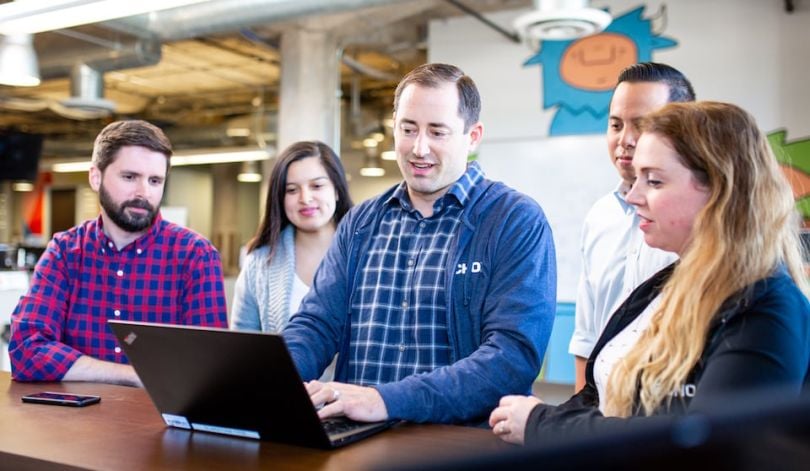Building software is one thing. Scaling it to accommodate a company’s rapid growth can be quite another.
So how do you ensure that your product can scale with your company? We spoke with leaders at five Chicago tech companies to find out.

Echo Global Logistics is a logistics technology company that helps companies efficiently outsource their shipping operations. Ilhan Kolko, vice president of product, said past successes and failures have helped shape the tech implementations the company uses today — and will continue to do so in the future.
How did a need for scalability impact your initial product?
Being at a company that grows so rapidly, scalability is always on the whiteboard during planning, designing and implementation. Everything we build needs to be future-proof and intelligently architected to support the constant progress.
Everything we build needs to be future-proof and intelligently architected to support the constant progress.”
How has your tech evolved over time to account for your company’s growth?
The same way the company grew; organically and inorganically via a variety of maturity cycles. Our approach has always been about being honest with ourselves when it comes to admitting failure; it is essential to derive learned lessons and make them a part of the evolution.
What’s most important to your team today in building new products and choosing new technologies?
Having agreed-upon strategic guidelines, respectable governance functions and a blueprint of the desired end state. The rest gets taken care of by the creative, tenacious talent in the shop.

Rewards Network provides financing, marketing resources and loyalty programs to restaurants, bars and nightclubs. Jeanne Steinback, vice president of software delivery, said developers choose tech based on whether it fits their needs and those of the business.
How did a need for scalability impact your initial product?
Rewards Network was purchased last September, and our new owners have plans that include very rapid growth in nearly every area of our business. We started a major green-field re-platforming project of our 34-year-old back-end system into a state-of-the-art Reactive fast data platform. The technologies we are using in this project will allow us to accommodate nearly any level of growth and set us up for years to come.
Our developers choose our tech because they are the people who learn, build and maintain apps with it.”
How has your tech evolved over time to account for your company’s growth?
Our tech did not evolve to account for our company’s growth — it is driving our company’s growth.
What’s most important to your team today in building new products and choosing new technologies?
That whatever we do provides maximum value to the company in terms of revenue, time savings, competitive edge or our ability to attract the best teammates possible. Our developers choose our tech because they are the people who learn, build and maintain apps with it. As long as it does the job efficiently, has a strong community or paid support and the team agrees that it solves a business problem, we will at least give it a try.

Pampered Chef makes cooking equipment such as cookbooks, cutlery and crock pots sold by a network of 40,000 independent consultants. Chief Operating Officer Andrew Treanor said adaptability to industry trends plays a big role in what technologies get implemented.
How did a need for scalability impact your initial product?
We analyzed our architectural and functional needs and decided to move to a composable cloud-first architecture centered around microservices. Technical and functional scalability are essential as we evolve our products. Using those patterns allowed us to address the technical scalability.
We can answer spikes in system load based on the nature of our business processes using elastic computing cloud services. We are utilizing the latest emerging technologies based on the MEAN stack [MongoDB, Express, Angular, Node], allowing us to provide new business-enabling applications supporting functional scalability and faster time to market.
We need to be singularly focused on choosing projects that will directly impact and improve our business.”
How has your tech evolved over time to account for your company’s growth?
Our technology team utilizes a cloud-first approach to power our independent sales consultants’ mobile businesses. The benefits are in the palm of their hands as we revolutionize our applications to run their businesses on the latest mobile devices. This is a direct result of paying attention to emerging technologies and being able to pivot around technology changes as needed.
What’s most important to your team today in building new products and choosing new technologies?
Enriching the lives of our customers and independent consultants. That often means we need to be singularly focused on choosing projects that will directly impact and improve our business. Continuous learning is crucial in the ever-changing technology industry, and we utilize frameworks that enable us to deliver faster and with better quality. While we are not always jumping on the latest trends, having an option to do so empowers our engineers to look outside the box and innovate.

Strike Social helps businesses execute more effective paid advertising campaigns through the use of artificial intelligence. Senior Test Automation Engineer Shushruta Patil said input from the diverse voices within the tech team greatly impacts the tools they, and the company as a whole, use.
How did a need for scalability impact your initial product?
As we move forward with supporting our customers on multiple social media platforms, we focus on creating software artifacts that are reusable and extensible. Most of our architecture leverages decoupled microservices, which allows us to scale horizontally as our business needs evolve. Recently, we have been experimenting with Lambdas and other serverless technologies, which scale more naturally and reduce costs for certain use cases.
We work together to evaluate the technical efficacy, business impact and cultural influence of any new technology.”
How has your tech evolved over time to account for your company’s growth?
There is a massive amount of data available from social media platforms, and our tech has evolved to retrieve, process and analyze this data faster. Sophisticated data management and transformation tools help us make sure the right data gets to the right person.
What’s most important to your team today in building new products and choosing new technologies?
Thorough research, evaluations of similar technologies and building working proofs of concept are frequent activities. We work together to evaluate the technical efficacy, business impact and cultural influence of any new technology. Our team consists of people with diverse technical and industry backgrounds, which helps us weigh in from multiple perspectives, giving us confidence about our choices.

Semantify is an AI-platform that provides companies with actionable insights into data that lies across disparate sources and allows users to interact with and visualize the results using simple English language queries. Vice President of Product Strategy Arjun Dutt said waves of new customer data use cases have helped spur the company’s tech evolution.
How did a need for scalability impact your initial product?
Early adopters of Semantify were large financial institutions with a variety of business needs. For this reason, it had to be architected to scale horizontally across different applications as well as vertically to allow an increasing volume of usage. Some key decisions, like choice of an open, portable technology stack based on Java, the ability to run on different operating environments and the use of components which did not lock us into a proprietary technology, were key early decisions in this respect.
The product and its underlying technology have evolved to accommodate newer use cases.”
How has your tech evolved over time to account for your company’s growth?
The product and its underlying technology have evolved to accommodate newer use cases based on the changing data environments of our customers — in particular, the emergence of unstructured information as a major data source. Similarly, innovations in visualization technologies have created a need to deliver more interactive, yet simple to use, user experiences for analysis of business information.
What’s most important to your team today in building new products and choosing new technologies?
The key criteria we use, beyond the obvious fit-to-need, are whether the technology is open, supported by standard APIs, flexible and configurable. We also look for proof points demonstrating scalability, resilience and compliance with security standards.





